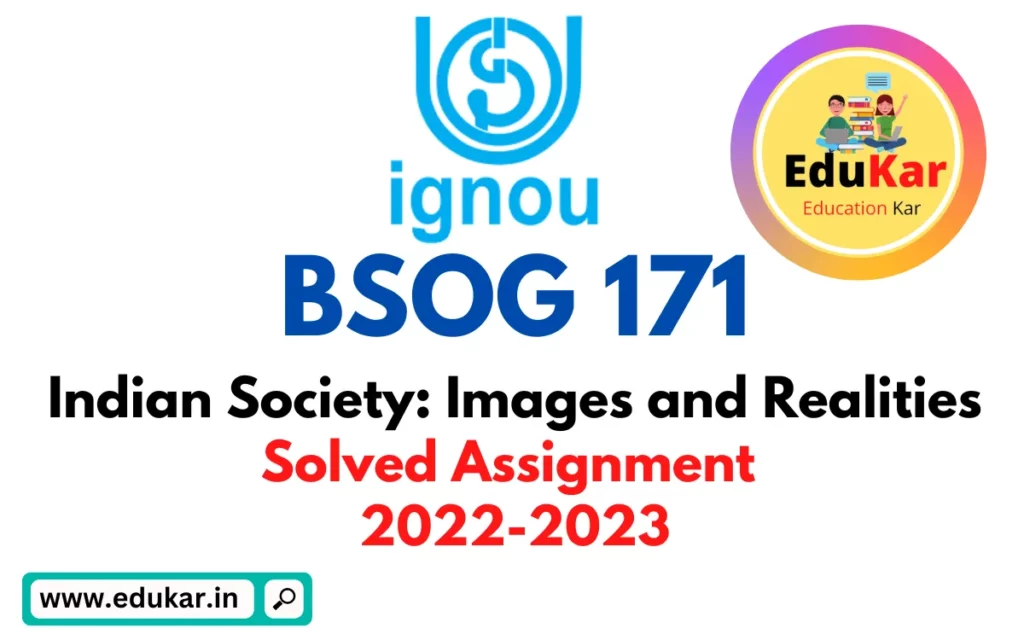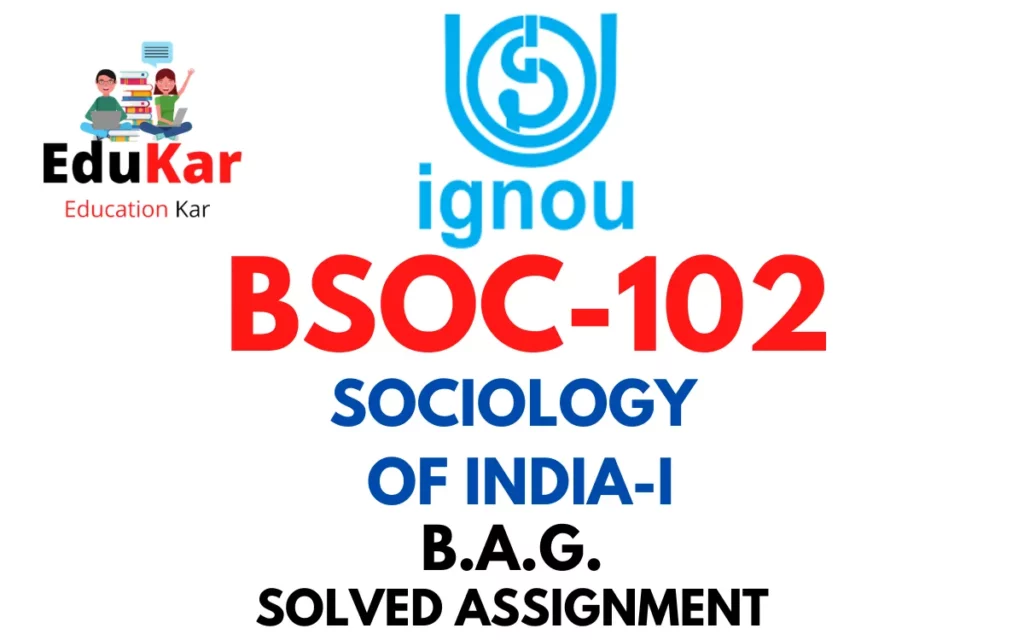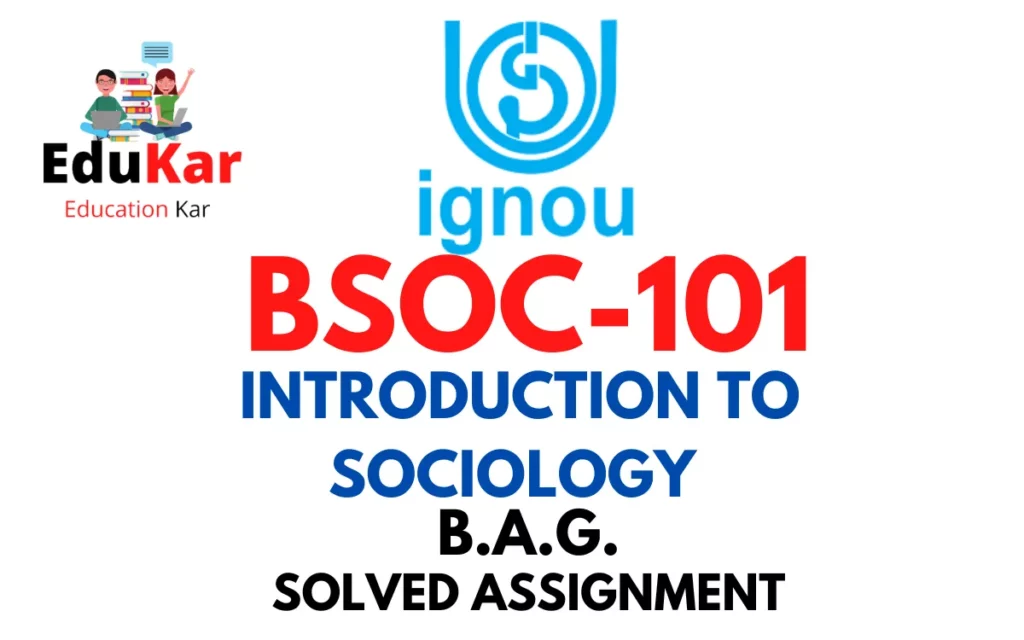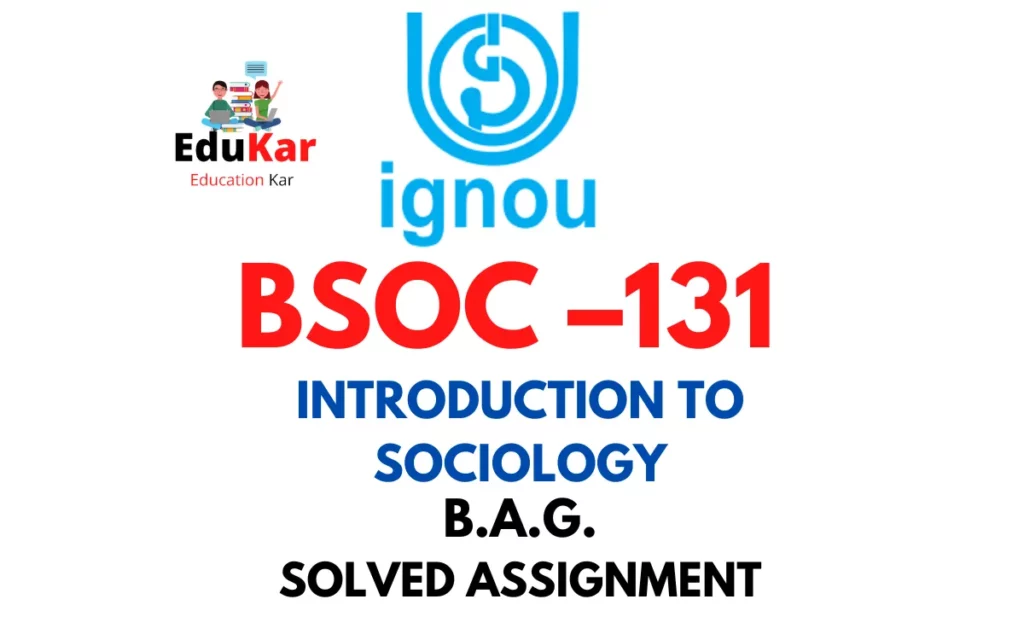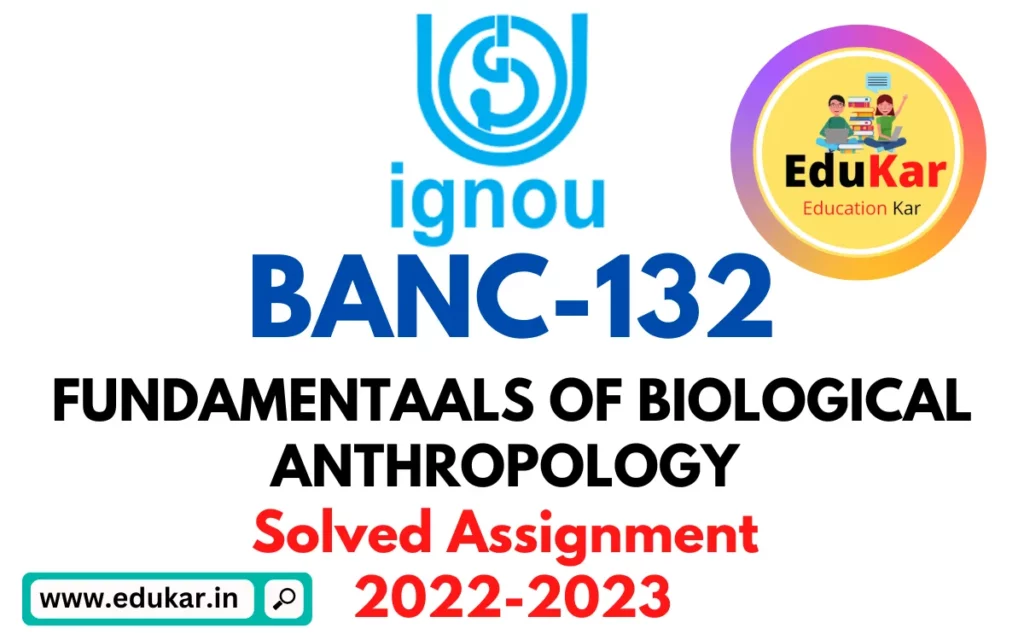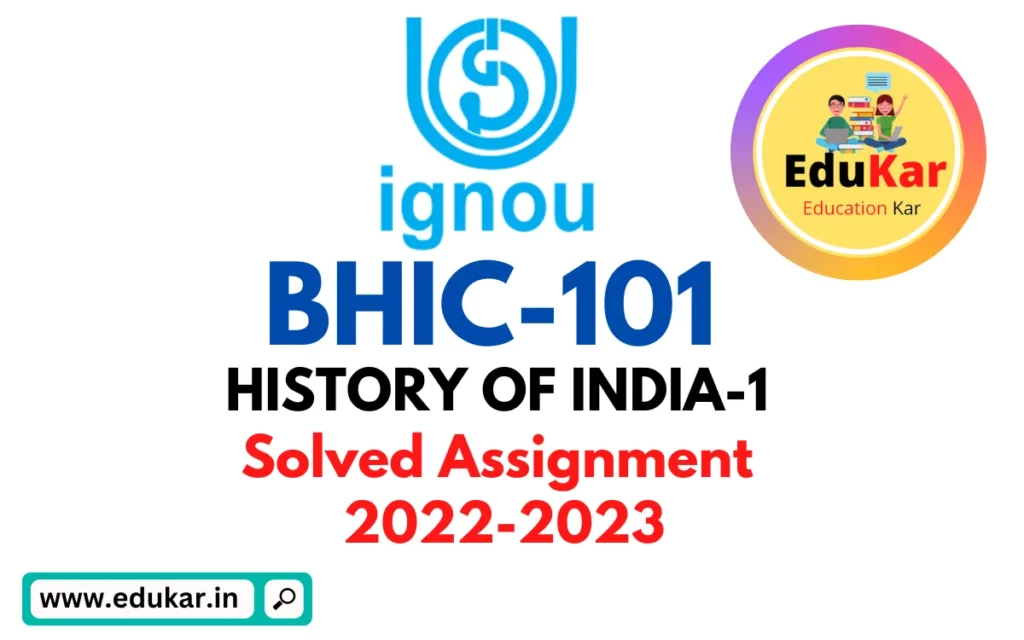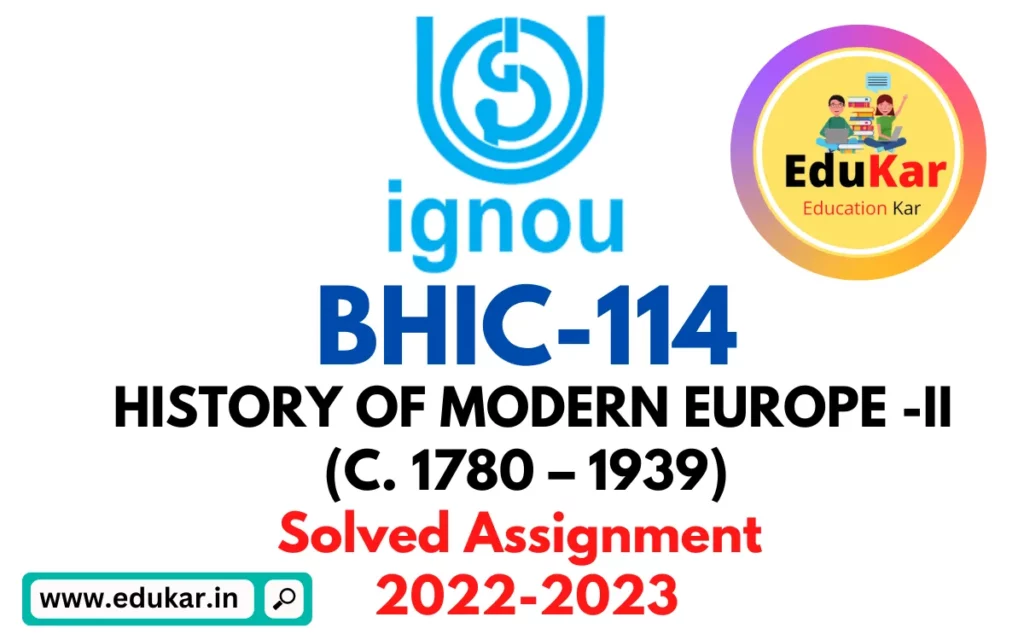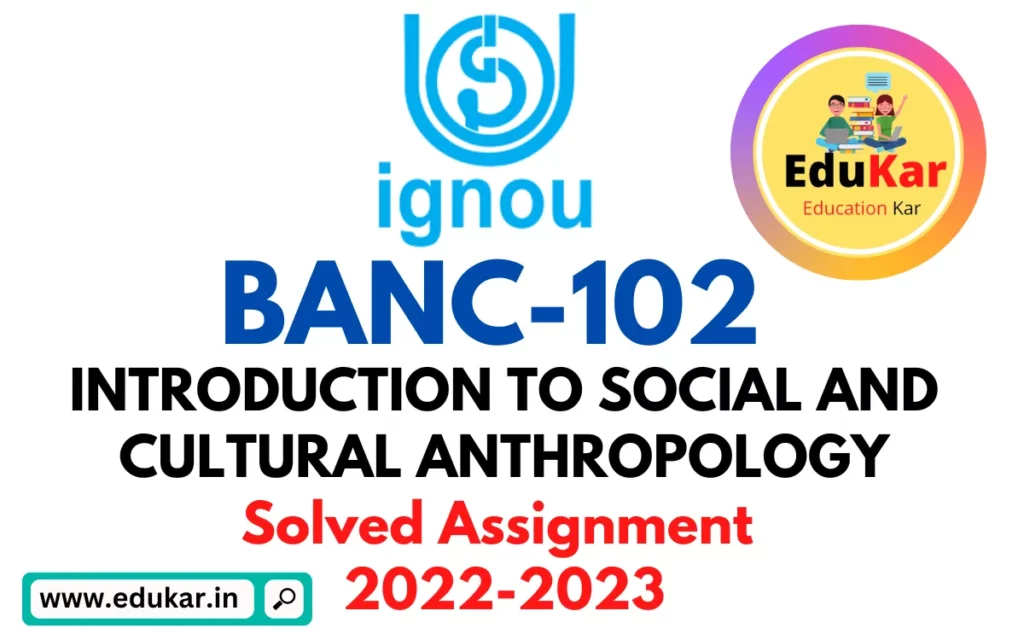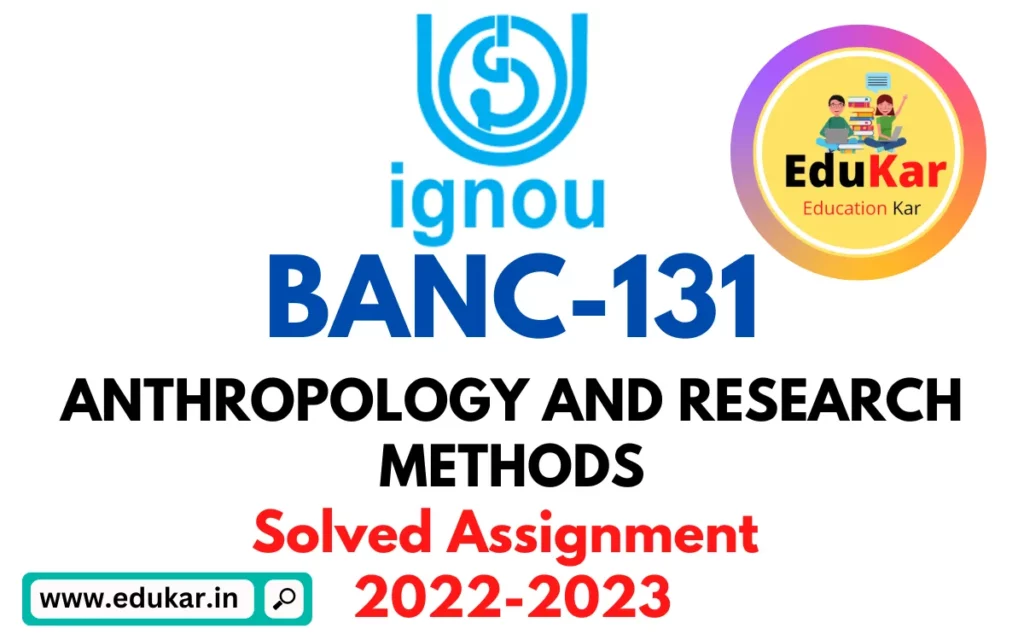Contents
- 1 Assignment – I
- 2 Answer the following in about 500 words each.
- 3 1. Discuss briefly the various approaches to study Indian society and culture.
- 4 2. Describe the linguistic elements of Indian population.
- 5 Assignment – II
- 6 Answer the following questions in about 250 words each.
- 7 3. Distinguish the concept of Varna and Caste.
- 8 4. Briefly describe the concept Nature-Man-Spirit Complex.
- 9 Answer the following questions in about 125 words each.
- 10 5. History of village studies
- 11 6. Dalits movements
- 12 Assignment – III
- 13 7. Urban Anthropology.
- 14 8. Briefly discuss about the fieldwork tradition in India.
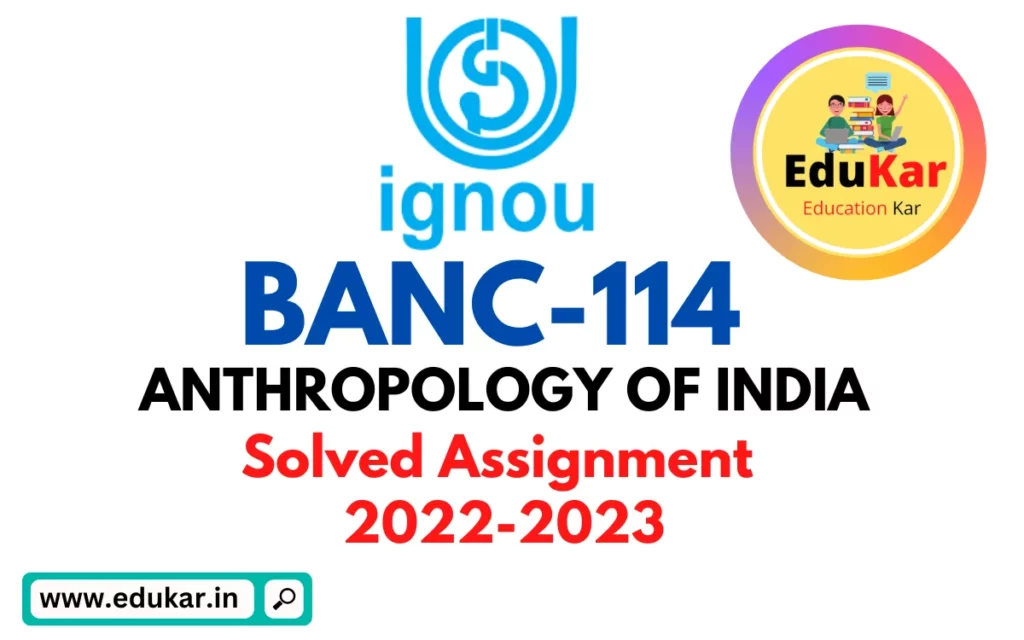
| Title | BANC-114: IGNOU BAG Solved Assignment 2022-2023 |
| University | IGNOU |
| Degree | Bachelor Degree Programme |
| Course Code | BANC-114 |
| Course Name | ANTHROPOLOGY OF INDIA |
| Programme Name | Bachelor of Arts (General) |
| Programme Code | BAG |
| Total Marks | 100 |
| Year | 2022-2023 |
| Language | English |
| Assignment Code | BANC 114/ASST/TMA/2022-23 |
| Last Date for Submission of Assignment: | For June Examination: 31st April For December Examination: 30th September |
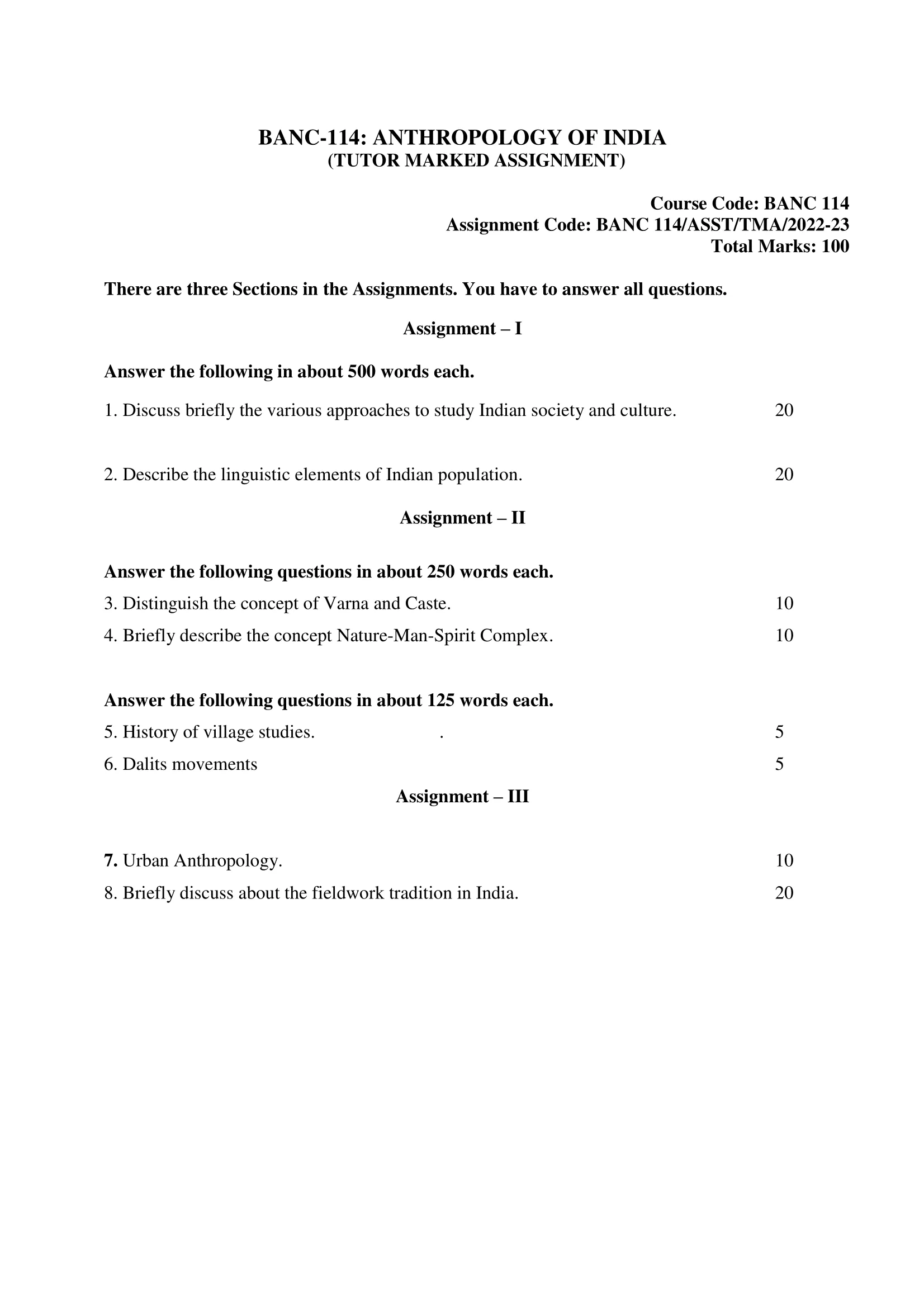
Assignment – I
Answer the following in about 500 words each.
1. Discuss briefly the various approaches to study Indian society and culture.
Ans: There are several approaches that have been used to study Indian society and culture, some of which are:
- Indological approach: This approach studies India from a historical perspective, focusing on ancient texts, such as the Vedas, Upanishads, and Puranas, to understand the evolution of Hinduism and the culture of ancient India.
- Anthropological approach: This approach focuses on the study of human societies and cultures, and is concerned with the understanding of cultural practices, beliefs, values, and social structures of Indian society.
- Sociological approach: This approach studies Indian society and culture by looking at the social structure and organization of society, and examining the relationships between different social groups and the factors that influence their behavior.
- Economic approach: This approach studies the economic system of Indian society, examining the role of the economy in shaping Indian culture, and exploring the impact of economic factors on the distribution of wealth and power.
- Political approach: This approach focuses on the study of politics and the state in Indian society, examining the role of the government and the political system in shaping the cultural, social and economic landscape of the country.
- Psychological approach: This approach studies the individual behavior and mental processes of people in Indian society, and examines how these factors influence cultural norms, values, and beliefs.
- Feminist approach: This approach examines the role of gender in shaping Indian society and culture, and focuses on the issues of gender inequality and women’s empowerment.
These approaches are not mutually exclusive and can often overlap, as many aspects of Indian society and culture are interconnected and interdependent. To gain a comprehensive understanding of Indian society and culture, it is important to adopt a multi-disciplinary approach that takes into account multiple perspectives and considers the interplay between different social, economic, political, and cultural factors.
2. Describe the linguistic elements of Indian population.
Ans: India is a country with a diverse linguistic landscape, where hundreds of languages and dialects are spoken. Here are some of the linguistic elements of the Indian population:
- Official Languages: The Constitution of India recognizes Hindi and English as the official languages of the country. Hindi is the most widely spoken language in India, while English is widely used as a second language, especially in business, education, and governance.
- Regional languages: There are many regional languages that are widely spoken in different parts of the country. Some of the most widely spoken regional languages in India include Bengali, Telugu, Marathi, Tamil, and Gujarati.
- Diverse dialects: Each regional language is further divided into several dialects that are specific to different regions, communities, and ethnic groups. This means that there is a rich diversity of dialects in India, which reflects the country’s linguistic diversity.
- Multilingualism: India is a country with a high degree of multilingualism, where people speak multiple languages and switch between them depending on the context. This is particularly true in urban areas where people from different linguistic backgrounds interact and communicate with each other.
- Scripts: The languages of India are written in different scripts, such as Devanagari (Hindi), Bengali, Telugu, and Tamil scripts. These scripts have a rich cultural and historical heritage and are an important part of the country’s linguistic heritage.
- Minority languages: There are also many minority languages that are spoken by small communities in India, such as tribal languages, and these are often endangered.
Assignment – II
Answer the following questions in about 250 words each.
3. Distinguish the concept of Varna and Caste.
Ans: Varna and Caste are two concepts in Hinduism that are often used interchangeably, but they have distinct meanings. Varna refers to the division of society into four main categories, namely Brahmins (priests and scholars), Kshatriyas (warriors and rulers), Vaishyas (merchants and farmers), and Shudras (workers and laborers). This division was based on a person’s inherent qualities and abilities, such as intelligence, bravery, and wealth, and was intended to ensure that everyone fulfilled their dharma (duty) in society.
On the other hand, Caste refers to the rigid, hereditary social stratification that has evolved in India over the centuries. The caste system divides society into thousands of endogamous groups, known as jatis, which determine a person’s occupation, social status, and life chances. The caste system has been characterized by extreme social and economic discrimination, with certain castes being considered “untouchable” and relegated to the lowest status in society.
While the concept of Varna was intended to be a flexible and fluid division of society, the caste system became rigid and oppressive over time. The caste system was further reinforced by the British colonial government, which used the caste system to divide and rule India, by granting certain privileges and rights to certain castes and denying them to others.
In modern India, the caste system still continues to shape the lives of millions of people and is widely regarded as one of the country’s major social and economic problems. Despite efforts by the Indian government and social reformers to eliminate the caste system and promote equality, it remains deeply ingrained in Indian society and continues to affect the lives of people in ways that range from employment opportunities to access to education and healthcare.
4. Briefly describe the concept Nature-Man-Spirit Complex.
Ans: The Nature-Man-Spirit Complex is a philosophical concept that explores the relationship between human beings, the natural world, and the spiritual realm. It seeks to understand how these three elements are interconnected and how they influence one another.
According to this concept, nature represents the physical world, including the environment and all living beings, while the spirit represents the realm of the divine, the supernatural, and the transcendent. The relationship between nature and spirit is mediated by human beings, who are seen as being part of both the natural and spiritual worlds.
The Nature-Man-Spirit Complex views human beings as both part of and separate from nature, with a unique ability to manipulate and interact with the natural world, while also having a spiritual dimension that transcends the physical. It emphasizes that human beings have a responsibility to care for and protect the natural world, recognizing the interconnectedness of all life and the impact that human actions have on the environment.
At the same time, the concept also stresses the importance of spirituality and the pursuit of the divine, recognizing that human beings have a deeper need for meaning, purpose, and connection that goes beyond the physical world.
Answer the following questions in about 125 words each.
5. History of village studies
Ans: The history of village studies can be traced back to the late 19th and early 20th centuries, when colonial administrators and anthropologists began conducting surveys of rural areas in India. These studies aimed to understand the social, economic, and cultural practices of rural communities, and were motivated by a desire to understand the lives of people in rural areas and to improve their living conditions.
During the post-independence period, the Indian government launched several development programs aimed at improving the lives of people in rural areas. This led to an increase in the number of village studies, as researchers sought to understand the impact of these programs on rural communities and to identify areas for improvement.
In the 1970s and 1980s, village studies in India shifted from a development-oriented perspective to a more critical perspective, as scholars began to examine the social, economic, and political structures that underpinned rural life in India.
Today, village studies continue to be an important area of research, as they provide insights into the complexities of rural life and help policymakers to develop effective development strategies for rural communities. Village studies also play an important role in promoting awareness about the diverse cultures and lifestyles of rural communities and the challenges they face in a rapidly changing world.
6. Dalits movements
Ans: Dalit movements refer to the political and social movements led by the Dalit community, who were previously known as “untouchables,” and who have faced systematic discrimination and oppression in India for centuries.
The Dalit movement emerged in the early 20th century as a response to the discrimination and oppression faced by the community, and aimed to secure their rights and improve their living conditions. The movement gained momentum in the post-independence period, as the Dalit community became more politically active and organized to demand equal rights and dignity.
The Dalit movement has been characterized by a range of strategies, including protests, demonstrations, legal challenges, and the formation of Dalit-led political parties. One of the most significant developments in the movement was the emergence of Dalit literary movements, which aimed to give voice to the experiences and perspectives of Dalits and to challenge the dominant cultural narratives.
In recent years, the Dalit movement has gained increased visibility, both within India and globally, as Dalit activists and leaders continue to raise awareness about the issues facing the community and to advocate for their rights. Despite some progress, however, the Dalit community continues to face widespread discrimination and exclusion, and the Dalit movement remains an important force for change and progress in India.
Assignment – III
7. Urban Anthropology.
Ans: Urban anthropology is a subfield of anthropology that focuses on the study of human societies and cultures in urban environments. It is a multidisciplinary field that draws on various disciplines, including sociology, geography, architecture, and economics, to study the cultural, social, and economic dynamics of cities and urban life.
Urban anthropology examines the ways in which people interact with the urban environment and how they create, maintain, and transform their communities, cultures, and identities in response to the challenges and opportunities of urban living. It also explores the processes of urbanization, the development and growth of cities, and the impact of urbanization on local and global environments, as well as on social and cultural practices.
Some key themes and topics in urban anthropology include:
- The social and cultural processes of city formation and urbanization
- The cultural, social, and economic diversity of urban populations, including issues of race, ethnicity, gender, and class
- The impact of globalization and globalization processes on cities and urban life
- The role of urban design, architecture, and built environment in shaping urban life and identity
- The impact of migration, migration patterns, and transnationalism on urban communities and cultures
- The role of urban governance, policy-making, and administration in shaping urban life and shaping the relationships between residents and the state
Urban anthropology provides valuable insights into the complexities and dynamics of urban life and the ways in which human societies and cultures are shaped by and adapt to the urban environment. It is an important field for anyone interested in understanding the cultural, social, and economic aspects of cities and urban life, and the impact of urbanization on human societies and cultures globally.
8. Briefly discuss about the fieldwork tradition in India.
Ans: Fieldwork is a central tradition in Indian anthropology, dating back to the early days of the discipline in India. Fieldwork in India is an approach to conducting anthropological research that emphasizes close engagement with the people, communities, and cultures being studied, usually through long-term immersion in a particular community.
In India, fieldwork has been an important method for anthropologists to study the diverse cultures, religions, and societies of the country, and has contributed to a rich tradition of ethnographic research. Some of the most famous Indian anthropologists, such as Verrier Elwin, Ghurye, and S.C. Dube, conducted fieldwork in various regions of the country, producing important studies on the cultures and traditions of the tribal and rural populations of India.
The fieldwork tradition in India has been shaped by several unique factors, including the country’s diverse linguistic and cultural landscape, its long history of colonialism and resistance to it, and the ongoing process of modernization and globalization. These factors have led Indian anthropologists to engage with a range of issues and themes, including caste and ethnic relations, religion and spirituality, gender and sexuality, and the impact of development and modernization on traditional communities.
The fieldwork tradition in India has also been influenced by the broader philosophical and theoretical debates in anthropology, including the debate between structural-functionalism and cultural materialism, and the critique of cultural imperialism. Indian anthropologists have contributed to these debates by offering insights from their own fieldwork experiences and by developing new theoretical approaches that are grounded in the Indian context.
How to Download BANC-114 Solved Assignment?
You can download it from the www.edukar.in, they have a big database for all the IGNOU solved assignments.
Is the BANC-114 Solved Assignment Free?
Yes this is absolutely free to download the solved assignment from www.edukar.in
What is the last submission date for BANC-114 Solved Assignment?
For June Examination: 31st April, For December Examination: 30th October

